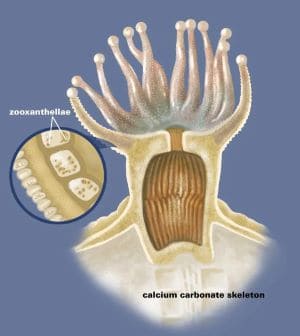Home › Sea Life › Coral Reef Formations › What is Coral
What is Coral: Plant or Animal
Most of the six thousand different coral species exist in warm, shallow, coastal waters. But, you can also find corals deep down in the darkness of open oceans.
In fact, corals are marine invertebrate animals that form huge underwater structures. Coral reefs provide sheltered habitats and food sources for 25% of fishes in the world.
Colourful Reefs are Tiny Colonial Organisms
The answer to the question of "is coral an animal or a plant" is a simple one.
Most coral reef formations look like they are colourful plants - anchored to the seabed by roots.
Here's the thing:
In fact, they are not plants at all. Corals are animals that fall within the Anthozoa (stony corals) class of marine invertebrates.
These tiny organisms are colonies that connect together as they grow.
Hence, individual coral polyps are interdependent on one another for nutrients and their survival as they colonise a reef structure. They use the electric charge of ions that exist in seawater to create their limestone exoskeletons.
A single polyp can be as small as a few millimetres or it can grow in excess of thirty (30) centimetres (12 inches), depending on the actual species of coral.
What are Corals Made Of?
Despite being animals, corals that build reefs in tropical regions will have microscopic plant-like organisms (algae) living inside the polyp tissues.
These zooxanthellae (pronounced zo-zan-THELL-ee) are vital for the survival of coral reefs around the world. Thus, the calcium carbonate skeleton provides a habitat for the algae, and the algae will provide a source of food for the corals.
Stony Corals (scleractinians)
Scleractinians lay the foundations in large reef structures. These individual stony coral organisms secrete a calcium carbonate framework (CaCO3) that builds up on itself and develops into various underwater structures.
Most of the polyps are tiny (e.g. less than three millimetres in diameter). But, with favourable conditions, their size can increase by around two (2) centimetres per year.
Key takeaways:
- A coral reef is a collection of both live and dead corals. Thus, all corals either are, or were, living organisms. They are not simply mineral rock! They are animal organisms, and each type has a symbiotic, life-supporting relationship with a primitive plant organism.
 In other words, coral is host to a plant form within (an algae) from which it collects nutritious by-products from algae photosynthesis.
In other words, coral is host to a plant form within (an algae) from which it collects nutritious by-products from algae photosynthesis.- Hence, most corals thrive better in shallow, clean water that gets plenty of bright sunlight.
- Some corals are sometimes confused, or wrongly described, as being a plant or a nonliving stone.
- This fallacy has been brought about because the coral has a hard skeleton of calcium carbonate (chalk).
- In fact, it is unlike most other skeletons in the animal kingdom because it spends its life "outside" the coral.
- It does not support the framework of the coral polyp. Instead it acts as a home and an anchorage point for the coral so it can secure itself to the ocean floor or other benthic structures (e.g. man-made reefs, rocks).
- The three parts of corals can be characterised as the main animal polyp, the plant form 'algae', and the inert calcium carbonate skeleton.
Pro Tip: Favourable conditions for corals to grow means an abundance of sunlight, consistent water temperature, and moderate wave action.
Difference Between Hard and Soft Corals
Marine biologists and zoologists will divide coral species into two basic kinds, that being either soft corals or hard corals.
Soft Corals
It's quite easy to mistake soft corals as being underwater plants, because they sway back and forth in the swells and currents. But, they are living animals - not plants.
Even so, soft corals have a small skeleton used as the anchorage point at the base. You will find them on the reefs laid down by the hard corals, as well as many other marine areas.
Hard Corals
The hard skeletal base of hard corals (e.g. staghorn coral), and the seemingly static existence, is why some divers confuse them as being made of rock.
So, even though they are living creatures 'initially', most of the hard corals differ from soft corals because they can produce substantial amounts of calcium carbonate (chalk).
This large, exterior skeleton gives reef-building coral the unique ability to build massive coral reef ecosystems over a period of many years.
Related Information and Help Guides
- How Do Artificial Reefs Help the Environment?
- Staghorn Coral: What Eats Staghorn Corals?
- Porites Stony Finger Coral Facts and Information
Note: The main section lists 10 simple steps to saving coral reefs and how daily decisions and actions can make a difference.